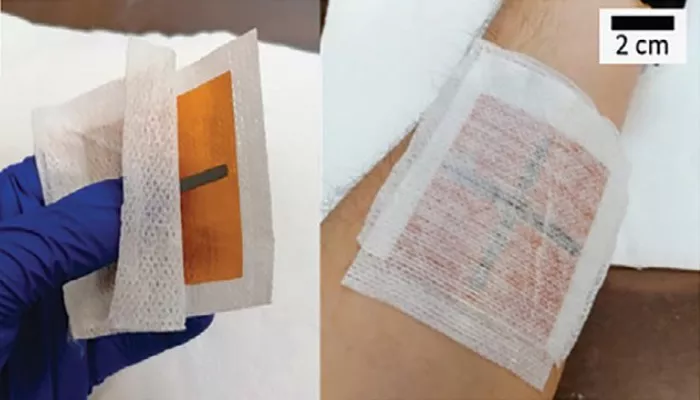An international team of researchers, led by the Universitat Rovira i Virgili (URV), has developed a groundbreaking medical device capable of continuously and accurately monitoring skin temperature. This innovative “e-tattoo” utilizes a thermoelectric system that functions without batteries or external power sources to detect subtle temperature variations linked to inflammation and infection. The findings of this project were recently published in Advanced Science.
The device was developed as part of a European research initiative in collaboration with the University of Porto, specialists in energy recovery systems. Initially aimed at enhancing sensor autonomy for both medical and industrial applications, the project sought to reduce reliance on batteries and create flexible devices adaptable to the skin or other surfaces. “The goal was to design flexible devices that could operate independently of external power sources and be comfortably worn on the skin,” said Eduard Llobet, a researcher at URV’s Department of Electronic, Electrical, and Automatic Engineering.
Temperature plays a crucial role in the early diagnosis of wounds and skin-related inflammatory conditions. Variations in local skin temperature can indicate infection, delayed healing, or other issues. Traditional methods, such as infrared cameras or point sensors, often require patients to remain still and are unable to cover large areas of skin. The newly developed device overcomes these limitations by accurately measuring even minor temperature changes and pinpointing areas of inflammation.
“The technology allows us to create a thermal map of the skin, highlighting areas of concern,” explained Llobet. This device is powered by a network of thermocouples—junctions of semiconductor materials that generate an electrical signal when exposed to temperature changes. It can detect temperature variations as small as 0.4°C and respond within three seconds, making it ideal for real-time wound monitoring and early infection detection.
The device was rigorously tested through both numerical simulations and experimental trials on human skin, including tests under simulated sweaty conditions using a saline solution. These tests validated the device’s ability to detect subtle temperature fluctuations and confirmed its effectiveness in real-world scenarios.
The device is made from flexible thermoelectric materials and a conductive polymer, printed using techniques similar to t-shirt printing. This enables the device to comfortably adhere to the skin while maintaining accuracy even in the presence of sweat or skin movement. “Unlike traditional sensors, this configuration is not only more precise but also more resistant to external interference,” said Llobet.
Researchers also evaluated the durability of the device by subjecting it to hundreds of bending cycles. The sensor maintained its functionality despite multiple deformations, a promising result for long-term use. Silvia de la Flor, head of URV’s Department of Mechanical Engineering, commented, “Our tests showed that the sensor retains its performance even after extensive use.”
The device provides easy-to-interpret data, displaying a color-coded temperature gradient map that allows healthcare professionals to quickly identify affected areas. This user-friendly system enables faster clinical decision-making and improves patient care.
Designed to be worn comfortably for several days, the device is as convenient as conventional medical monitoring tools. “It can be worn without causing discomfort, allowing for continuous monitoring,” said De la Flor.
This technological advancement paves the way for more personalized and accessible medical care. In addition to preventing infections in surgical wounds and pressure ulcers, the device can be adapted for monitoring other inflammatory conditions and used in medical applications such as treatment packs. The research team is also working on expanding the device’s capabilities, including the integration of biosensors to measure additional physiological markers like dissolved gases or biomarkers. “Our goal is to continue developing this technology to enhance its versatility and clinical utility,” concluded the researchers.
Related topics:

